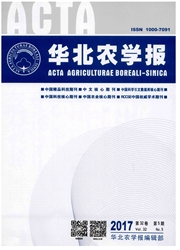

 中文摘要:
中文摘要:
对西瓜枯萎病菌生理小种1诱导的抑制差减杂交cDNA文库测序获得的4 000条EST进行分析,经过前处理后拼接得到1 487条unigene序列,全长为759 kb。在其中978条unigene序列中共检索出2 136个EST-SSR,出现频率为53.4%。EST-SSR的平均分布距离和平均长度分别是1/0.36 kb、19.59 bp。EST-SSRs中的重复单元以二核苷酸和三核苷酸重复为主,二者在总EST-SSRs中的出现频率为98.08%。GA/TC和GAA/TTC是二、三核苷酸中的优势重复类型,分别占二、三核苷酸重复的25.78%和12.97%。西瓜抗枯萎病相关EST资源的SSR信息分析为进一步建立西瓜EST-SSR标记和探索其在西瓜基因组学研究中的应用奠定了基础。
 英文摘要:
英文摘要:
Simple sequence repeats (SSRs) were investigated in the unigene sequences from suppression subtractive hybridization(SSH) cDNA library which constructed with watermelon root induced by Fusarium oxysporumf, sp. niveum race 1. A total of 1487 unigene sequences corresponding to 795 kb were searched, resulting in the identification of 2 136 SSRs. The estimated frequency of SSRs was approximtely 53.4%, and the overall average length of SSRs was 19.59 bp, the average distance of distribution were 1/0.36 kb. The di- and tri-nucleotide repeats appeared to be the most abundant SSRs, accounting for 98.08 % in all the EST-SSRs. The adentine rich repeats such as GA/TC and GAA/TYC were predominant in each type of SSRs (di-,tri-),accounting for 25.78% and 12.97% in di- and tri-nucleotide repeats respectively. These EST-SSRs information could be efficiently exploited for the development of gene-derived SSR markers.
 同期刊论文项目
同期刊论文项目
 同项目期刊论文
同项目期刊论文
 期刊信息
期刊信息
